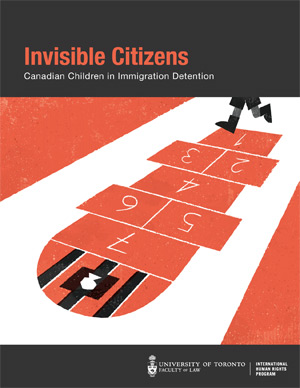
The International Human Rights Program of the University of Toronto has just released a new report on the detention of children in Canada, urging alternatives to detaining children and family separation.
The 57-page report, Invisible Citizens: Canadian Children in Immigration Detention, is a follow-up to the IHRP’s September 2016 report on non-Canadian children in immigration detention, “No Life for a Child”: A Roadmap to End Immigration Detention of Children and Family Separation. The new report reiterates that families in detention should be released outright or given access to community-based alternatives to detention, such as reporting obligations, financial deposits and guarantors.
“Since 2011, Canada has housed more than two hundred Canadian children in detention in Toronto’s Immigration Holding Centre, alongside hundreds of formally detained non-Canadian children, according to the report Invisible Citizens: Canadian Children in Immigration Detention (PDF) from the University of Toronto’s International Human Rights Program (IHRP). The report recommends that Canada urgently implement alternatives to the detention of children rather than confining them in immigration detention facilities or separating them from their detained parents.
 “The IHRP interviewed nine detained and formerly detained mothers of Canadian children from the Middle East, West Africa, Central America and the Caribbean. The mothers described the arbitrary and rigid rules of the detention facilities in Toronto and Laval, and how the conditions eroded their capacity to effectively protect and care for their children.
“The IHRP interviewed nine detained and formerly detained mothers of Canadian children from the Middle East, West Africa, Central America and the Caribbean. The mothers described the arbitrary and rigid rules of the detention facilities in Toronto and Laval, and how the conditions eroded their capacity to effectively protect and care for their children.
““Canadian children are invisible in Canada’s immigration detention system,” said Samer Muscati, IHRP director. “While all detention of children is horrible, these children are particularly vulnerable because they lack important legal safeguards, including their own detention review hearings.”
“According to figures recently obtained by the IHRP through access to information requests, an average of at least 48 Canadian children were housed in detention each year between 2011 and 2015 in Toronto alone. New figures released by Canada Border Services Agency (CBSA) to the IHRP in February 2017 indicate a significant decrease over the past year, as CBSA has taken some important initial steps to address long-standing problems. However, the IHRP is concerned that the frequency of family separation has not seen a similar reduction, and that the best interests of children do not receive adequate attention from immigration authorities.
“Invisible Citizens is based on interviews conducted since November 2016 with lawyers, social workers, refugee advocates, mental health experts, as well as detained and formerly detained mothers. The report includes six case studies of Canadian children who were housed in detention or separated from their detained parents in Toronto and Laval. Without exception, the mothers expressed anguish about the detrimental consequences of the experience on their children’s physical and mental health.
“One of the children profiled in the report, Daevon, was four months old when officials detained his mother, Abigail (not their real names), at the Toronto detention facility. Abigail was detained because CBSA suspected that she was a flight risk, and Daevon accompanied her as a “guest” of the facility. According to Abigail, she constantly felt pressured by CBSA to part with her infant son. “But I’m his mom, I’m his caregiver, he’s breastfeeding, how can he leave?” she said. After three months in detention, Abigail was diagnosed with Major Depressive Episode and Complex Post-Traumatic Stress Disorder. “I think they robbed a lot from me and my baby.”
“The report builds upon years of advocacy by Canada-based refugee and child rights groups that have called on the government to ensure that children’s best interests are a primary consideration in decisions that affect them, and ultimately, to end child detention and family separation. International bodies have also repeatedly criticized Canada for its immigration detention practices.”
More information in here.